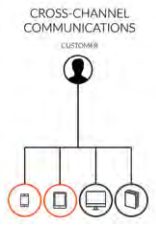10.5: Multi-channel commerce to total retail
- Page ID
- 24918
In addition to being available on specific channels, eCommerce also forms part of other retail approaches. It is important to understand what these approaches are and where eCommerce fits into the broader strategy of your business.
Multi-channel commerce
When your business operates across multiple sales and media channels, you are considered to be engaging in multi-channel commerce. For instance, you might sell your products on your website, a mobile app, via a call centre, in stores, on Amazon and on eBay, all while communicating with customers via many types of devices and social media channels. You utilize a variety of multiple sales and marketing channels to sell your products to different types of users and, therefore, you’re a multi-channel vendor.

Cross-channel commerce
When your business encourages its customers to interact with your business on more than one channel, you are engaging in cross-channel commerce. Essentially cross-channel commerce is the strategic maximization of customer relationships via the introduction of new channels beyond the one that originally engaged the user.
A customer would have approached a brand via a specific channel to browse and initiate purchase, and cross-channel retailers would encourage that customer to then make use of other available shopping channels, such as the website, app or social media platforms, to engage further with the brand. Cross-channel retailers encourage interactions on their terms. Such interaction across channels increases the likeliness of additional conversions and future sales.

Omnichannel commerce
An omnichannel commerce strategy can be defined as a retailing strategy that delivers a seamless customer experience through all available shopping channels. What distinguishes the omnichannel customer experience from the multi-channel customer experience is that with the latter there is true integration between channels on the back end including customer data (single view of customer), inventory management, stock movement, supply-chain, fulfilment information and customer relationship management.
The customer’s interaction with the brand is integrated across all channels. Customers can seamlessly migrate from channel to channel with no interruption or loss of data, and can pick up wherever in their customer journey they may be irrespective of which channel they choose to engage the brand.
Customers are becoming increasingly digitally savvy, and expect to be able to engage with the brand across a variety of channels, depending on what is most convenient to them. They expect these interactions to be seamless, backed by an integrated system across all channels. In short, customers expect an omnichannel commerce experience, and are frustrated by what they see as inferior brands, that fail to provide this.

Further Reading: 7 Inspiring Examples of Omnichannel User Experiences by Aaron Agius: blog.hubspot. com/marketing/ omni-channel-userexperience-examples#s m.00001gxdf8f6orey1z5 ftxme7hlbh
Total retail
A seamless experience across all channels should arguably be a point of parity, rather than a differentiator. With thousands of brands competing for business, there is a need to go one better than omnichannel and offer their customers an enhanced and personalised online shopping experience if they want to satisfy and retain their customers. In 2014, PwC termed this approach of providing a seamless, enhanced and personal retail experience as going, “Total retail” (PwC, 2014).
Total retail means two things:
- A unified brand story across all channels that promises a consistently superior customer experience.
- An integrated back office operating model with agile and innovative technology.

Total retail is a more customer centric approach than omni-channel. It still offers a seamless experience to the user across channels, but it places the individual customer’s experience at the heart of all its business operations. The focus is on the customer, rather than the various channels that can be used to reach the customer.
According to PwC (2014) it is consumer expectations that are driving this new retail business model. Customers are quick to take their business elsewhere if they are not satisfied with their online shopping experience. Brands need to respond by doing what they can to make their eCommerce offering enjoyable, seamless and as convenient as possible. To enable this, brands need to invest in customer-focused technologies that can track customers across the various channels and aim to achieve a single view of customer.



